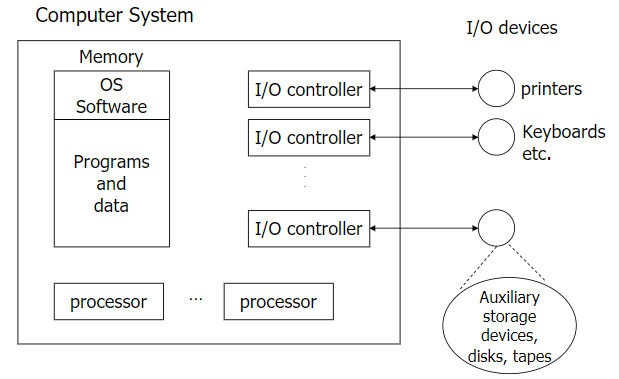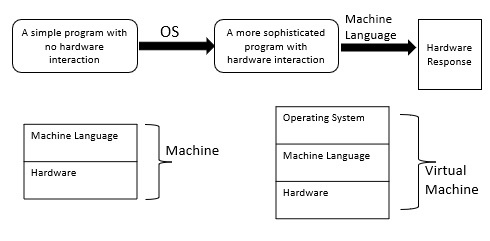An operating system is an interface between the user and the machine which controls and coordinates the use of the hardware among the various application programs for the various users.
Operating System as Resource Manager
Let us understand how the operating system works as a Resource Manager.
Nowadays all modern computers consist of processors, memories, timers, network interfaces, printers, and so many other devices.
The operating system provides for an orderly and controlled allocation of the processors, memories, and I/O devices among the various programs in the bottom-up view.
The operating system allows multiple programs to be in memory and run at the same time.
Resource management includes multiplexing or sharing resources in two different ways: in time and in space.
In time-multiplexed, different programs take a chance of using CPU. The first one tries to use the resource, then the next one that is ready in the queue, and so on. For example: Sharing the printer one after another.
In space multiplexing, Instead of the customers taking a chance, each one gets part of the resource. For example − The main memory is divided into several running programs, so each one can be resident at the same time.
The diagram given below shows the functioning of OS as a resource manager −

Operating System as Extended Machine
Let us understand how the operating system works as an Extended Machine.
At the Machine level, the structure of a computer’s system is complicated to program, mainly for input or output. Programmers do not deal with hardware. They will always mainly focus on implementing software. Therefore, a level of abstraction is supposed to be maintained.
Operating systems provide a layer of abstraction for using disks such as files.
This level of abstraction allows a program to create, write, and read files, without dealing with the details of how the hardware actually works.
The level of abstraction is the key to managing the complexity.
Good abstractions turn an impossible task into two manageable tasks.
The first is to define and implement the abstractions.
The second is to solve the problem at hand.
The operating system provides abstractions to application programs in a top-down view.
For example − It is easier to deal with photos, emails, songs, and Web pages than with the details of these files on disks.
The diagram given below shows the functioning of OS as an extended machine −

Related Questions & Answers
- What are the Process States in Operating System?
- Write about Process Control Block.
- Write Various Operating System Services.
- What is the requirement to solve the Critical Section Problem?
- Write about the Priority Inversion Problem.
- Write various multithreading models.
- Discuss preemptive scheduling.
- Consider the following set of processes........
- Write about Semaphores. Explain its properties along with drawbacks.
- Write necessary conditions for arise of Deadlock.
- Define the following Terms: Mutual Exclusion, Thrashing, Thread
- Explain the features of Time sharing system.
- What is an operating system? Give the view of OS as a resource manager.
- Explain the following UNIX Commands: (a) grep (b) chmod (c) finger (d) cat (e) sort
- What is the thread? Explain thread Structure? And explain any one type of thread in detail.
- What is PCB? Discuss its major fields.
- List the four events that cause processes to be created. Explain each in brief.
- Explain the producer-consumer problem and its solution using the monitor.
- List Deadlock recovery techniques and explain any one of them.
- Write a short note in Critical Section.
- Explain context switching.
- Differentiate between Multi-Programming and Multi-Processing System.
- Write different types of system calls?
- What is a scheduler? Explain queuing diagram representation of process scheduler.
- Define the following Terms: Throughput, Waiting Time, Turnaround Time, Response Time.
- What is deadlock? List the conditions that lead to deadlock.
- Explain Banker’s algorithm for multiple resources with examples.
- What is Semaphore? Give the implementation of Bounded Buffer.
- What is Mutex? Write pseudocode to achieve mutual exclusion using Mutex.
- Explain the IPC problem. Explain the Dining Philosopher problem.

